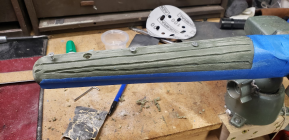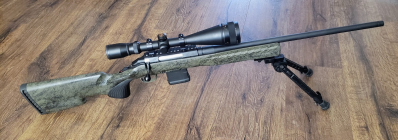I have been thinking about this for a couple of years and tried dozens of products and nothing really sticks to the plastic (Acrylonitrile Butadiene Styrene, Polypolypropylene, polyethylene)
The other day I got to thinking chrome plating steel. It will not stick to steel so they first plate it with nickle. Well, after a project working on my camper's storage lid I searched for a glue that would stick to polyethylene to add some braces. West Marine G-flex 650 will stick to it after flame treating.
So, I prepped the worst part of the stock side rail where the action sits. Painted on a really thin coat of g flex, let it set up for a couple of days then put some marine tex and Devcon 10110 and both stuck well.
Without the G Flex you could peel up both with your fingernail. Not now though, to bad the G Flex does stay slightly flexable so it's not good to use as the bedding compound.
M.Ezell
Gold $$ Contributor
Cool. You might look up a product called smc resin. It's specifically for hard to adhere to plactics where mold release agent is blended into the plastic/panels. Common in body shops, especially corvettes.
Even still, I always form a mechanical bond by milling or dremelling grooves and holes etc into the plastic.. Never had a failure that way, yet.
Thanks for the tip! You sound like a man on a mission - and won.
I guess I should explain a little more, this is for hunting rifle applications so having a plastic, fiberglass type stock is beneficial as it WILL rain here in Florida and a reason the Devcon is out as well since the steel powder will surface rust and why I use Marine Tex.
I have 7 or 8 of the darn things laying around so if possible I was going to put them to use.
Infinity Bond MMA 500 bonds hard-to-adhere plastics like PE and PP. Achieve permanent bonds in minutes with little surface prep. Learn more today.

www.gluegun.com
Might be worth looking at
There is still the problem of polyolefins (polyethylene and polypropylene). The same reason they make great plastics is the reason they are hard to bond to: Inertness. Epoxies and urethanes work by polymerization in which part of the molecules of the resin un-bond leaving an active site to bond to themselves or to the substrate. In the case of olefins, their inertness makes it difficult for those open bonds to re-attach to the substrate surface. In industry, they use treatments like plasma surface activation where the olefins are broken open by a UV-oxygen plasma to generate active sights for the polymers to bond to. There are chemical activators that work too, but they are expensive and for me, those cheap poly stocks are just not worth the time and money.
I just clean it, drill small holes at different angles for mechanical attachment. Use JB Weld, D 10110, polyester boat resin, epoxy glue, whatever. Never had anything come loose. And I have worked on more tupperware stocks than I can remember.
Marine Tex may be the world’s greatest stuff, but they are just too proud of their product “price wise” for Me too use it, unless someone gives it too Me free.
For hunting that g-flex under there wont hurt anything. I just gouge it up good and use JB weld. Never had any come loose but also never picked at it. Truthfully if it was loose in there it wouldnt hurt anything as long as it was sandwiched between and cradled each piece perfectly
If it's slick plastic..... won't even attempt to list the ingredients..... there's a good chance we've used it in the shop. Wear strips,guides,blocks etc. for fixtures and all sorts of "stuff" going on 50 years.
We've found that if you use a typical propane torch and pass it lit, over the area of HDPE (or similar)..... not trying to heat it up,that's for heat guns and electric griddles...
A chemical/physical change happens apparently.... but it'll give you almost a 30 minute window in which to do the glue up. Really hard to quantify the results. Although,we do test WAY harder in this environment than what is generally encountered on stock bedding.
As mentioned above,bedding is sort of a sandwich. Epoxy a wear strip on a fixture.... every dang time a part gets loaded,it's being put to the test. Just saying,I feel we're well beyond what's expected when looking at adhesion tests.
Cheap a$$,junky tupperware OEM stocks;
I'm a glutton for punishment when it comes to these. Have pretty much perfected it now..... to cut to the chase. Forget carbon,or any material arrows. Or anything "round".... way too much flex. Think boxing it. On a rifle,it's the up/down axis that you need to work on. So build the "beam" with that in mind. Good luck with your project.
I've done 5-6 'tupperware' stocks and haven't had any issues with adhesion... sanding drum with 80 grit to rough up the stock and then clean it with acetone.
On the pillars, I reduce the O.D. on the tops so the Pro Bed locks on to the pillars. The pillars are 'short' of hard contact with the receiver to allow a good amount of bedding thickness.
If you don't pillar them to remove the stock flex when the screws are tightened, you won't get any longevity from the bedding.
Good shootin' -Al
If it's slick plastic..... won't even attempt to list the ingredients..... there's a good chance we've used it in the shop. Wear strips,guides,blocks etc. for fixtures and all sorts of "stuff" going on 50 years.
We've found that if you use a typical propane torch and pass it lit, over the area of HDPE (or similar)..... not trying to heat it up,that's for heat guns and electric griddles...
A chemical/physical change happens apparently.... but it'll give you almost a 30 minute window in which to do the glue up. Really hard to quantify the results. Although,we do test WAY harder in this environment than what is generally encountered on stock bedding.
As mentioned above,bedding is sort of a sandwich. Epoxy a wear strip on a fixture.... every dang time a part gets loaded,it's being put to the test. Just saying,I feel we're well beyond what's expected when looking at adhesion tests.
Cheap a$$,junky tupperware OEM stocks;
I'm a glutton for punishment when it comes to these. Have pretty much perfected it now..... to cut to the chase. Forget carbon,or any material arrows. Or anything "round".... way too much flex. Think boxing it. On a rifle,it's the up/down axis that you need to work on. So build the "beam" with that in mind. Good luck with your project.
When flame treating PE and PP plastics you can test if you did it enough by putting a little water on it. If it sheets off you did it right, if it beads up its not ready.
I've done 5-6 'tupperware' stocks and haven't had any issues with adhesion... sanding drum with 80 grit to rough up the stock and then clean it with acetone.
On the pillars, I reduce the O.D. on the tops so the Pro Bed locks on to the pillars. The pillars are 'short' of hard contact with the receiver to allow a good amount of bedding thickness.
If you don't pillar them to remove the stock flex when the screws are tightened, you won't get any longevity from the bedding.
Good shootin' -Al
Score it up with a utility knife as well. Gives some nice raised surfaces for the glue to bite
I've been scuffing mine up with a rasp bit on a drill or Dremel. Add in some small holes in different directions.
Clean with starting fluid (it contains no oils).
Spray with automotive adhesion promoter.
Bed with Devcon using a toothpick to push it into the holes i drilled.
I've also used this to fill & stiffen the forestock with lightweight Bondo.
Here is a Ruger Predator stock I just did. I wanted an inexpensive rifle to use for a Wildcat build but after shooting it was Impressed with how accurate it was. Instead of buying another stock I decided to spend a few hours and modify this one. This is how I always prep when working on a plastic stock. Sand with 60 grit, use a dremel and give plenty of places for a mechanical attachment. Next photo is finished, built it to fit me and it is really comfortable. Super accurate. $20 in materials. Thats a Tikka grip on it so $35 total.


I guess I should explain a little more, this is for hunting rifle applications so having a plastic, fiberglass type stock is beneficial as it WILL rain here in Florida and a reason the Devcon is out as well since the steel powder will surface rust and why I use Marine Tex.
I have 7 or 8 of the darn things laying around so if possible I was going to put them to use.
They make Devcon with aluminum powder and also Titanium powder.













